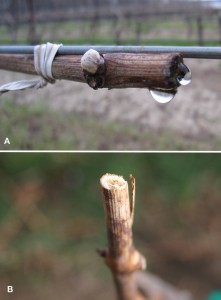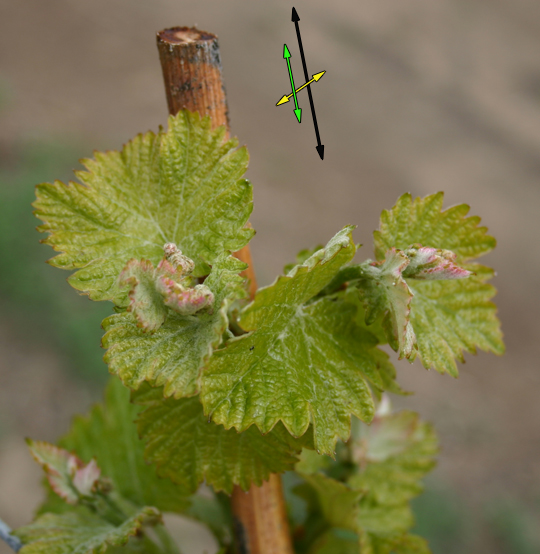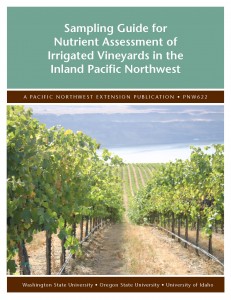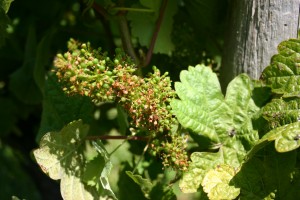Click here to download a pdf of the Combined 2012 Vintage Updates
13 April 2012
By Michelle Moyer, Viticulture Extension Specialist; Gary Grove, Plant Pathologist; and Markus Keller, Research Viticulturist
Irrigation, Vine “Bleeding” and Impact on Early Season Development

A sure sign of spring is “bleeding” (sap flow) from pruning wounds on grapevines. “Bleeding” is likely caused by root pressure due to sufficient moisture uptake by the vine. Low precipitation during the 2011-2012 winter season has resulted in low soil moisture content this spring for many locations. Insufficient soil moisture which may result in poor root pressure, has and been associated with erratic budbreak, stunted shoot growth, and/or cluster abortion early in the growing season. Are your vines bleeding, and if not, do you know what the soil moisture levels are in your vineyard (either high tech with neutron probes, or low tech by sight and feel)?
Irrigation channels are full for the season, so if your soil moisture content is low and you are noticing dry pruning wounds, now would be an appropriate time to consider a “pre-season” irrigation application.
New Fungicide Approved for Grape Disease Management
The WSDA has approved a new fungicide for disease management (Powdery Mildew and Botrytis Bunch Rot) in wine grapes. Luna Experience, a Bayer product, is a premix of fluopyram and tebuconazole. Fluopyram is a FRAC group 7 (SDHI) compound, while tebuconazole is a group 3 (DMI) compound. This fungicide can be used in rotation with group 11 compounds (QoI’s such as Flint, etc.) to help mitigate resistance development. NOTE: 1) The boscalid component of Pristine is also a group 7 compound, so keep resistance management guidelines in mind when using these two products. 2) This product has not been approved for use on juice grapes.
Growing Degree Days
April 1 is the official start of the growing degree day accumulation season. Be sure to check your local AgWeatherNet station (http://weather.wsu.edu) for updated GDD information, and check back to the WSU V&E website toward the beginning of May for GDD graphs that are updated every 7-14 days. http://wine.wsu.edu/research-extension/weather/growing-degree-days/
27 April 2012
By Michelle Moyer, Viticulture Extension Specialist, and Gary Grove, Plant Pathologist
Flirting with Summer
If the last week are a taste of what’s to come, bring on the summer heat! With temperatures rising to 90°F over the weekend and into the early part of the, vine development quickly went from a few days behind to right on schedule for most of the region. The heat also put growing degree day accumulation on track for an average year (Fig. 1). However, as mentioned in the past, GDD accumulation alone is not a good measure of heat or vintage quality, but this “normal” start is a welcome change from the GDD curves of 2010 and 2011.
Starting off with below normal precipitation, 2012 caused some initial concern regarding soil and vine water status going into the season. However, the recent rains have alleviated these concerns, and have quickly caught us up to average precipitation levels (Fig. 2). While great for vine growth and development, especially when coupled with the aforementioned heat, there are a few spurious potential side effects, discussed below.
April Showers Bring May Outbreaks
Post-budbreak rain events promote primary powdery mildew (PM) infections. However, early applications of fungicides can be tricky due to other factors: temperature, wind, and attempts to avoid soil compaction after heavy rain. Below are a few things to consider when starting your management regime for the current growing season.
To spray, or not to spray? Whether a recent rain event should send you out the door and onto a sprayer is dependent on several factors. If you have high disease pressure from last year, or routinely have issues at that site, then that would favor and early start to a spray regime. While environmental factors can influence the ascospore release and infection processes of the PM fungus, infection is also a function of susceptible, exposed, grape tissue. If you are not at budbreak, or at the very early stages of growth, you have a very small exposed surface area (and thus, reduced change of infection). In addition, developing grape buds and tissue are very pubescent (hairy), which can also slow down infection, via creating a physical maze the germinating fungal spore must get through to find susceptible tissue. The greatest infection risk in the early season begins when shoots are 4-6”. Primary infection events (0.1” rain, at or above 50°F) should not be taken lightly at after this stage of shoot growth.
If the answer is “To spray”, the next question is: “With what?” Early in the game, the best tools for management are those products with multiple modes of action and have some slight eradication activity. Luckily for both organic and conventional management, these two tools are the same, and they are sulfur (flowable sulfurs are preferred for early season application)* or narrow-range petroleum oils. If temperatures are cool, and conditions are dry, intervals can be long after these first applications, but if heavy rains follow application, consider wash-off potential when determining your intervals. HOWEVER be careful when applying sulfur or oils, and do not rotate between the two at tight (<14 day) intervals, as you increase the risk of a phytotoxic response. If PM was severe in the vineyard last year, consider tank-mixing sulfur or oil with a synthetic fungicide early in your 2012 management program.
*Lime sulfur is not recommended. Past reports that used dormant applications to reduce overwintering PM were done experimentally in conjunction with means to control other diseases not currently present in WA. For effective PM control, dormant applications need thorough wetting of the bark (300 gal/acre) at close to 6X the legally labeled rates. To use it at a rate that would be effective would be in violation of label recommendations, and thus, illegal. Non-dormant applications are also not recommended. See Gadoury, et al. 1994. Plant Disease.
Using Decision Support Systems and AgWeatherNet
Decision support systems (DSS) are designed to provide the information that aids in determining the best course of action for the question at hand. In Washington, there are multiple DSS, both free and for a fee, that are available for growers. AgAlertz, a service powered with WSU’s AgWeatherNet data, provides risk alerts for PM (Grape, Cherry, and Hop). Alerts indicate the level of risk (low-medium-high) for PM infection, and are sent right to your email address, text box, or voice mailbox.
Alternatively, you can also view a Grape Powdery Mildew model that provides risk indices directly on the AgWeatherNet website. It provides extensive detail on spray intervals and what products are available. Information can be pushed to your email or test messaging device if that feature is chosen in your user profile. There is also a model available for Botrytis bunch rot.
Both systems use data from AgWeatherNet stations. Don’t have a station near your site? Pick the closest 2-3 and use alerts and indices from those sites as a best-estimate for risk at your location. Some information is better than none when trying to make a management decision.
A PM problem during the past growing season normally indicates the need for early grower intervention in the current season. The best way to control powdery mildew is to stay ahead of it!
Corrections and Additions to the 2012 Washington State Grape Pest Management Guide (EB0762)
Fungicide approvals post-press:
Luna Experience, Bayer premix formulation of fluopyram and tebuconazole, was registered for use on winegrapes in Washington in February. Application rates are 5.0 – 8.6 oz/A for powdery mildew and 8.0 – 8.6 oz/A for Botrytis bunch rot. Fluopyram is a FRAC group 7 (SDHI) fungicide while tebuconazole is a group 3 (DMI) compound. This fungicide can be used to take some of the resistance heat off of the group 11 (QoI’s such as Flint, etc.) compounds. The boscalid component of Pristine is also a group 7 compound, so keep the resistance management guidelines in mind. As mentioned in previously, Luna Experience has not been approved for use on juice grapes. Another Bayer compound, Luna Sensation (trifloxystrobin/fluopyram) was approved for use in pome and stone fruits.
Quadris Top, a premix of difenconazole (FRAC group 3; DMI) and azoxystrobin (FRAC group 11, QoI), is also an excellent fungicide for powdery mildew management. Caution should be noted, however, since it is a mixture of both a group 3 and a group 11 fungicide. As with any azoxystrobin compound, be cautious when spraying near apple orchards, as phytotoxic issues can arise with in apples with Macintosh parentage.
Addenda:
There are also few corrections to the Pest Management Guide. On page 22, the sentence reads “…with the exception of Inspire Super, have activity against powdery mildew (only the tebuconazole component of Inspire Super is active against the disease).” It should read “…with the exception of Inspire Super, have activity against powdery mildew (only the difenconazole component of Inspire Super is active against the disease).”
In addition, Table 1 inadvertently left out Elite (tebuconazole) and Procure (triflumizole) from the list of Fungicides and Active Ingredients. Both are DMI’s (FRAC group 3), with good PM efficacy and medium resistance risk.
We apologize for any inconvenience this may have caused!
11 May 2012
By Michelle Moyer, Viticulture Extension Specialist
Are Those Shoots from Primary or Secondary Buds?
After cold events, like the Thanksgiving 2010 Freeze, or during routine shoot thinning, this question often comes up. Why? Because there can be sizable fruitfulness differences between primary and secondary shoots. In the case of potential freeze damage of shoots, knowing if the emerging shoots are from primary or secondary buds can help in early-season yield estimations/adjustments. In the case of shoot thinning prior to clear visibility of the clusters, knowing shoot origin can help you keep the more fruitful primary bud shoot.
To help answer this question, it is important to know that plants like “order” and grapes are no exception. You can use this “ordering” (termed phyllotaxy) to help determine if a shoot is from a primary or secondary bud.
Each node on growing shoot contains a group of buds. The first bud contains what could develop as a summer lateral shoot. The other buds are grouped together into the compound, overwintering bud. This compound bud contains a primary bud, a secondary bud, and a tertiary bud. If you think in terms of generations, the main shoot is the “mother” generation (N), the lateral shoot is a first generation (N+1), the primary bud is the second generation (N+2) and the secondary and tertiary buds are the third generation (N+3). The basic phyllotaxy of grape leaves on the mother shoot is alternate-opposite, or in other words, leaves will arise on opposite sides of the shoot in an alternating fashion. However, there is a 90° re-orientation of the shoots with each generation. Therefore, the orientation of the primary bud (N+2) will appear to be the same as the mother shoot (N), since it will be offset by 180°. Shoots from N+3 buds will be at right angles to the mother shoot. In Fig. 1, a shoot is arising from both the primary and secondary bud at a single node. In this case, the shoot on the left is from a primary bud, and the shoot on the right is from a secondary bud. The basic take home: If the petiole (or leaf) orientation of the new shoot runs parallel (green arrow, Fig. 1) to the length of the spur/cane (black arrow, Fig. 1), that is a shoot from a primary bud. If it is perpendicular (yellow arrow, Fig. 1), it is a shoot from a secondary bud.

A Note on Fungicide Resistance Management
Fungicide resistance management should really be called “Sustainable Fungicide Use”. Sustainability has many meanings, but the definition provided in the Merriam-Webster dictionary is: of, relating to, or being a method of harvesting or using a resource so that the resource is not depleted or permanently damaged. The longevity of any pesticide is dependent upon its efficacy, and inappropriate use of that product will deteriorate (or outright eliminate) its usefulness in the future.
Many people view managing fungicide resistance development as the rotation of their “big-gun” products during critical periods of disease control in grapevines, typically during the bloom period when considering Powdery Mildew (PM) and Botrytis Bunch Rot (BBR). This rotation is based on alternating fungicides with different FRAC (Fungicide Resistance Action Committee) codes. FRAC codes are assigned to fungicides based on their modes of action (how they kill/suppress a fungus).
There are reports that in light of potential pressure arising from high PM disease levels in 2011, some growers are already using products such as DMIs (FRAC group 3) and QoIs (FRAC group 11). While these products are typically highly effective at controlling PM, they are also highly prone to resistance development. There are also limitations on their annual use: DMIs (or premixed products containing FRAC group 3 compounds) should not be applied more than 3x a season, and never more than 2 times in sequence; QoIs (or premixed products containing FRAC group 11 compounds) should not be applied more than 2-3x a season and never in sequence. While early use of synthetic fungicides might be warranted in locations with high PM pressure, be aware of your season-total application limit when using DMIs and QoIs, and consider tank-mixing with sulfur or oil to aid in resistance management.
REMINDER
Corrections and Additions to the 2012 Washington State Grape Pest Management Guide (EB0762)
Fungicide approvals post-press: Luna Experience, Bayer premix formulation of fluopyram and tebuconazole, was registered for use on winegrapes in Washington in February. Application rates are 5.0 – 8.6 oz/A for powdery mildew and 8.0 – 8.6 oz/A for Botrytis bunch rot. Fluopyram is a FRAC group 7 (SDHI) fungicide while tebuconazole is a group 3 (DMI) compound. This fungicide can be used to take some of the resistance heat off of the group 11 (QoI’s such as Flint, etc.) compounds. The boscalid component of Pristine is also a group 7 compound, so keep the resistance management guidelines in mind. As mentioned in previously, Luna Experience has not been approved for use on juice grapes. Another Bayer compound, Luna Sensation (trifloxystrobin/fluopyram) was approved for use in pome and stone fruits.
Quadris Top, a premix of difenconazole (FRAC group 3; DMI) and azoxystrobin (FRAC group 11, QoI), is also an excellent fungicide for powdery mildew management. Caution should be noted, however, since it is a mixture of both a group 3 and a group 11 fungicide. As with any azoxystrobin compound, be cautious when spraying near apple orchards, as phytotoxic issues can arise with in apples with Macintosh parentage.
Addenda: There are also few corrections to the Pest Management Guide. On page 22, the sentence reads “…with the exception of Inspire Super, have activity against powdery mildew (only the tebuconazole component of Inspire Super is active against the disease).” It should read “…with the exception of Inspire Super, have activity against powdery mildew (only the difenconazole component of Inspire Super is active against the disease).”
In addition, Table 1 inadvertently left out Elite (tebuconazole) and Procure (triflumizole) from the list of Fungicides and Active Ingredients. Both are DMI’s (FRAC group 3), with good PM efficacy and medium resistance risk.
We apologize for any inconvenience this may have caused!
25 May 2012
By Michelle Moyer, Viticulture Extension Specialist
 The 2012 growing season is marching forward, going into the bloom period with growing degree day accumulations and precipitation mirroring historical averages in most AVA representative locations.
The 2012 growing season is marching forward, going into the bloom period with growing degree day accumulations and precipitation mirroring historical averages in most AVA representative locations.
A few locations are still seeing the ramifications of the 2010 Thanksgiving freeze, noted by reduce shoot vigor and spur position skips on vines that were damaged, but not sufficiently so to be retrained. Across the Valley, there were increasing reports of erratic budbreak and poor shoot development over the last few weeks; this was attributed to the dry winter conditions and insufficient soil moisture as mentioned in previous Vintage Updates. Recent rains, however, helped level the playing field in terms of vine growth. Of course, this silver lining came with a cloud, which was increasing powdery mildew pressure related to infection events and overall favorable weather for development.
Recurrent frosts in May have also touched some vineyards, particularly in the Puget Sound and Walla Walla Valley AVAs. While shoot damage has occurred, no major reports of crop loss were made, as these events were light and early enough for clusters to escape significant damage.
Nutrient Status and Tissue Testing
As we rapidly approach the onset of bloom, knowing the nutritional status of your vine is important to avoid potential yield and quality issues. Deficiencies in micronutrients such as boron (B) or zinc (Zn) can result in poor pollen viability, and ultimately, poor fruit set. In severe cases, poor fruit set can substantially limit yield; in other cases, reduced fruit set is compensated by the plant via increased berry size and thus, a lower skin : volume ratio, which may be undesirable in certain varieties of wine grapes.
The best way to know if vine problems are related to nutritional deficiencies is to test for them. Generalized fertilization regimes, especially with micronutrients, can result in either insufficient application to correct the problem (and thus, wasted application time and money), or excess application that can result in vine toxicity. While soil tests do provide an estimate of potentially available nutrients for vines, they do not represent the vine nutritional status, and soil deficiencies are not always manifested in the vine, and vice versa. In an establishing and established vineyard, the best way to determine vine nutritional status is coupling the results of a tissue test with that of visual cues of vine health. While the ideal timing to do tissue testing is often debated, the common ground all share is that: 1) You should do tissue testing before determining your fertilizing regimes; and 2) You should tissue test at a similar time each year to aid in annual comparisons. The two current favored times for tissue testing are at either bloom or véraison; current recommendations by WSU favor the véraison sampling period. Additional guidelines for tissue testing can be found in the Extension publication: PNW622 titled “Sampling Guide for Nutrient Assessment of Irrigated Vineyards in the Inland Pacific Northwest.”
Nitrogen: Peak vine accumulation of nitrogen (N) is between bloom and véraison, with a uptake particularly high near bloom (Schreiner, 2006). Similar results were also seen in Concord (Pradubsuk and Davenport, 2010). Application of nitrogen prior to budbreak, or before soils reach a temperature of at least 55ºF is inefficient, and does not maximize vine uptake. If you have not applied N and you need to, we are approaching an ideal time to do so. NOTE: Vines uptake nutrients via water, so irrigation is essential during broadcast/soil application of nutrients.
For those who might be interested, Oregon State University’s Viticulture Extension program has an excellent online learning-module related to vine nutrition and nutritional deficiency diagnosis. It is an interactive OSU Extension Publication #EM9024, titled “Grapevine Nutrition”. In addition, eXtension.org, a website for National Extension activities, has an excellent online article regarding Grapevine Nutrition.
Pradubsuk, S., and J.R. Davenport. 2011. Seasonal Distribution of Micronutrients in Mature ‘Concord’ Grape: Boron, Iron, Manganese, Copper, and Zinc. J. Amer. Soc. Hort. Sci. 135:69-77.
Schreiner, R.P., and C.F. Scagel. 2006. Nutrient Uptake and Distribution in a Mature ‘Pinot noir’ vineyard. HortSci. 41:334-345.
Recap of Powdery Mildew Alert (Originally emailed: 23 May 2012)
By Gary Grove, Plant Pathologist, and Michelle Moyer, Viticulture Extension Specialist, WSU-IAREC
The precipitation / warm temperatures early this week (Sunday, 20 May and Monday, 21 May) in eastern Washington were ideal for primary infection (i.e. epidemic initiation) by the grapevine powdery mildew fungus.
Similar conditions were seen in mid-April, however, bud burst had not occurred in many locations. The powdery mildew fungus requires green, photosynthetic tissue for infection, growth, and reproduction, making these April primary infection events “marginal”. The recent disease-conducive precipitation / temperature conditions during the prebloom period are a serious concern.
Fortunately, the windy and cool weather predicted for the next several days should help reduce the reproductive speeds and spread of powdery mildew. However, growers should assume that the recent weather conditions resulted in disease establishment in local vineyards. This assumption is necessary in proactive disease management, as environmental conditions can change rapidly, and the fungus can respond to those changes with equivalent speed.
We are entering the critical period for infection of fruit, which will last for about 6 weeks and runs from approx. 2 weeks prebloom to 3 weeks post-fruitset. Apply fungicides at recommended rates, intervals, and ensure good spray coverage. Keep tractor speeds at less than 4 mph, do not practice every-other row spraying, and if you haven’t done so already, make sure all nozzles are functioning properly.
We have been watching our untreated Chardonnay vines and to date, have not seen symptoms and signs of powdery mildew. We will be checking these vines almost daily, and will notify you when we observe the first symptoms.
15 June 2012
By Michelle Moyer, Viticulture Extension Specialist
Despite the cooler weather, growing degree day accumulations for 2012 are only slightly below long-term averages, but almost double what they were this time last year. Unfortunately, this “cooler” weather was also associated with high levels of precipitation, with some places receiving close to 15% their yearly total in less than a week. These temperatures and moisture, during a time of rapid growth, have many hoping for drier weather— not only to get out and spray, but to also control the vigorous canopy development. Fertilization success is also temperature-driven, with optimal temperatures between 75-85ºF, so fruit set is highly dependent on weather in the upcoming weeks as we progress through bloom.
New Irrigation Scheduling Tool- Made for your Smartphone or other mobile, internet-capable device!
As we (hopefully) approach the season of regulated deficit irrigation, WSU’s Irrigation Extension Specialist Dr. Troy Peters, in close collaboration with AgWeatherNet, have developed a mobile website to help with irrigation scheduling and water management. If you haven’t seen it yet, check it out at: http://weather.wsu.edu/is/ . Multiple vineyards can be archived (“Fields”) and many of the input parameters are adjustable so you can fine-tune your information output.
We are in the “Critical Period” for Powdery Mildew Management on Clusters

The recent ideal temperatures and rain were and are ideal environmental conditions for powdery mildew (PM) spread and infection. We are also in the “Critical Period” where fruit are fully exposed and highly susceptible (~2 weeks prebloom to 3 weeks post fruit-set). In addition, these rains and cooler nights are leading to high levels of cap retention in clusters, creating an excess of debris which is an excellent food source for the Botrytis bunch rot fungus. It is highly advisable, if you haven’t done so already, to make sure developing clusters are protected during this Critical Period. Use tight spray intervals, do not cut fungicide rates, and use dual- purpose fungicides when appropriate. Monitor weather conditions on AgWeatherNet, and use the Grape Powdery Mildew model to help understand how weather relates to infection risk. If you haven’t done so already, pick up a copy of the 2012 Pest Management Guide for Washington Vineyards.
Need Pesticide Recertification Credits? Go Online!
Did you know that WSU offers several online-modules you can take to help earn Pesticide Applicators Recertification Credits? Check out the courses at: http://pep.wsu.edu/rct/RecertOnline.html
13 July 2012
By Michelle Moyer, Viticulture Extension Specialist
The Vintage Thus Far
After weathering a cool bloom period with the occasional isolated thunderstorm, it looks like summer is finally here! With above-average temperatures settling in over the last week in the Valley, most of Washington is seeing a catch-up in growing degree days (Fig. 1).

While we tend to associate warmer temperatures with advancement in vine development, more heat is not always better. Vines begin to shut down at temperatures above 95ºF; so time above that threshold may indicate time lost for the plant. When calculating growing degree day (GDD) accumulation, compare accumulation from standard calculations, to that of setting an upper temperature threshold of 95ºF. NOTE: This high-temperature threshold is treated differently in calculations than the low-temperature threshold (base). When temperatures exceed an upper threshold, the maximum temperature is reset to the threshold. This is not the case in most standard calculations of GDD when dealing with base (minimum) temperatures.
For example, the “active” heat unit accumulation in 2012 to 11 July, with thresholds at 50 and 95ºF would be 987 GDD vs. 1021 GDD (standard calculation), indicating that vine advancement may not be as far along as one would expect. In 2011, a “cool year”, there was no difference in accumulation. In 2003, a “warm year”, it would be 1045 GDD vs. 1048 GDD, indicating that while 2012 and 2003 may not appear to be that different in total heat accumulation to date, 2003 had more active heat units (1045 GDD) than the current vintage (987 GDD).
This difference in GDD calculation is a reminder that there are many ways to describe a vintage, and using something such as GDD accumulation should considered in the greater context of how a season is unfolding. While such calculations allow us to easily compare one vintage to another, in the case of GDD, it does not provide a description of the quality of those heat units, only the quantity. Things to keep in mind: Is the heat accumulating at a time that is appropriate during key stages of vine development? What are the other associated environmental conditions (rain, wind, storm systems), and importantly for temperature, how long (in a 24 hr period) were the durations of the maximum and minimum temperatures?
We are ending the “Critical Period” for Powdery Mildew Management on Clusters
The development of resistance in aging clusters, combined with high temperatures and low relative humidity, are quickly diminishing the favorability of powdery mildew (PM) spread in eastern Washington. Temperatures still remain conducive, if not slightly on the cooler side, for spread in western Washington. As most vineyards approach or are completing bunch closure, management of potential Botrytis bunch rot (BBR) colonization is still warranted, although waning until the onset of véraison. As we approach véraison, monitor weather conditions on AgWeatherNet, as ideal conditions (e.g. wet and cool) between véraison and harvest can create challenges in BBR management, and negate any management interventions deployed during bloom. If you haven’t done so already, pick up a copy of the 2012 Pest Management Guide for Washington Vineyards to aid in spray planning.
24 August 2012
The Vintage thus Far
Michelle Moyer, Viticulture Extension Specialist

Sometimes average is good, especially when it comes to weather. Coming out of two vintages noted by below average temperatures, it is a welcome reprieve that 2012 is heading down the middle of the road, on par with long-term average temperature accumulation (Fig. 1). As a result, much of the Valley is at mid-véraison, tracking towards a “normal”, or slightly advanced, harvest date.
Precipitation, however, is another beast (Fig. 2). While seasonal accumulation is above normal, most of this occurred in early June, and the lack of significant rainfall the last couple of weeks, coupled with routine temperatures above 90ºF, may be placing some vineyards under drought stress, particularly those practicing deficit irrigation. Reference evapotranspiration, a calculation of the amount of water that is lost through a plant, has been above normal for August (Fig. 3), highlighting this potential for water stress.
When vines are under drought stress, they will produce abscisic acid (ABA), which tells stomata (plant pores involved in transpiration) to close, which helps reduce plant water loss. Unfortunately, this water loss also helps cool plant tissue, and when stomata close in hot, sunny days, tissue can super heat. Photosynthesis and many metabolic processes involved with berry ripening are temperature sensitive, and will shut down when temperatures reach extremes (both hot and cold).
While we associate higher temperatures with advanced ripening, when these high temperatures are coupled with severe water stress, ripening will actually slow down or stop. Just be aware that watering decisions should be coupled with both visual and measured signs of plant water stress.
Water Stress and Atypical Aging Flavor Defect
Thomas Henick-Kling, WSU V&E Program Director
Water stress has been linked to Atypical Aging (ATA) in white wine. Wines with the ATA defect lose their varietal flavors quickly, sometimes within the first year, and atypical flavors such as candle wax, Linden tree blossoms, dusty roadside, furniture varnish, and dirty dish rag will appear. The wines will also develop a metallic, bitter taste. Research done in Europe and work I did at Cornell University has linked drought stress to the onset of ATA. Particularly, the time period immediately surround véraison (about 2 weeks before and after) appears to be the most critical; however, the exact period is not known. Also, we do not know exactly, how severe the water stress needs to be, nor how long it needs to last.
We know that water stress close to the point where photosynthesis shuts down (stem water potential below -1 MPa), for a period of about 1 week, can cause ATA. Of course, when photosynthesis shuts down or very nearly shuts down, flavor development also stops. With the recent hot temperatures, and our rapid advancement through véraison, keep an eye on vine water status.
A more in-depth look at ATA and how to manage it in the winery will be presented in the Fall issue of the Viticulture and Enology Extension Newsletter (VEEN).

